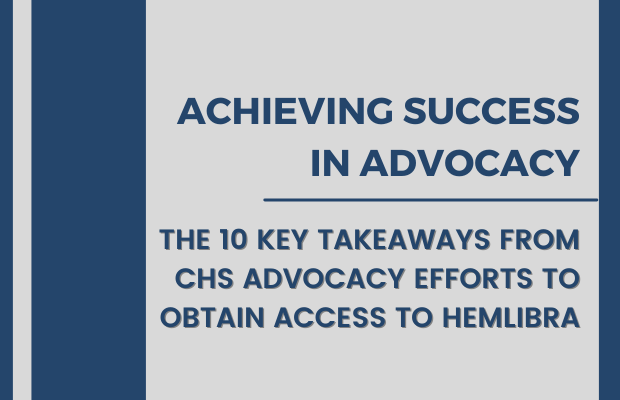The 10 key takeaways from CHS advocacy efforts to obtain access to emicizumab (Hemlibra)

by David Page, CHS National Director of Health Policy
The Canadian Hemophilia Society (CHS), its chapters and members have expended great efforts to advocate for funding for emicizumab (Hemlibra) in recent years. These efforts were successful in achieving access for those …
- with FVIII inhibitors across the country in mid-2019
- with severe hemophilia A without inhibitors in the provinces and territories served by Canadian Blood Services (CBS) in October 2021 and
- with severe hemophilia A without inhibitors in Québec in April 2022.
It is important to look back and identify the reasons why the CHS was successful, despite the very challenging context of a global pandemic in 2020 and 2021. There will almost certainly be other advances in coagulation products in the coming years. Knowing the recipe for success will serve as a guide for future advocacy efforts.
What were the 10 keys to success?
- With Hemlibra, the CHS was advocating for a therapy with well-demonstrated benefits: subcutaneous administration and steady-state hemostatic protection. Being a clear breakthrough in care, it was a relatively easy case to make to the provinces/territories who had to fund it, despite the neutral or negative recommendations coming from the health technology assessment bodies, CADTH and INESSS. Make a strong evidence-based case.
- There was strong international consensus on introducing this therapy. By the time the provinces and territories were ready to make their decisions, Hemlibra had become “standard of care” in many countries. Canada was shown to be falling far behind. Show international precedents.
- The CHS made strong, evidence-based submissions to CADTH and CBS, and in Quebec to INESSS and to CCNMT (Comité consultatif national en médecine transfusionnelle). These submissions included the CHS’ own research on the lived experience of patients using factor VIII concentrates and Canadian data from the PROBE study on patient reported outcomes. Collect, analyze and present the patient lived experience.
- The CHS and the AHCDC (Association of Hemophilia Clinic Directors of Canada) were perfectly aligned. The AHCDC was supportive of CHS recommendations on the importance of funding Hemlibra and made its own submission to CBS. It also supported CHS critiques of the HTA methodology that questioned Hemlibra’s efficacy in comparison to FVIII. Consensus between the patient and physician groups is absolutely essential. Create a patient/physician unified front.
- The CHS had excellent relations with both CBS and Héma-Québec which allowed it to make the case to them with credibility. It also had close relationships with certain key individuals in influential positions in the health bureaucracies. Know the system and nurture relationships.
- The CHS was able to demonstrate in well-researched submissions to CBS and Héma-Québec, using publicly available economic data, that the introduction of Hemlibra for the inhibitor population could result in budget savings and, for the non-inhibitor population, in budget neutrality. Follow the money.
- Both CBS and Héma-Québec demonstrated their real interest in procuring therapies that contributed to excellent patient care; both expended significant resources to negotiate contracts that would allow this to happen. Maintain close contacts with the blood establishments.
- The CHS worked very hard with the manufacturer over several years to encourage it to be competitive if it hoped to enter the market. To its credit, the manufacturer was determined to bring its product to the Canadian market and be competitive in comparison with established treatments. Work with pharmaceutical companies to reach common goals.
- The hemophilia community made its voice heard. In the first month of the on-line campaign, over 10,000 emails were sent to local politicians and provincial Ministers of Health. Members spoke directly to their local legislative representatives and even to Ministers of Health. Some chapters had the issue raised in their provincial legislatures. Others created ad hoc committees to coordinate their advocacy work. Inform and involve the patients/caregivers. Help them to make their voices heard.
- Make the story public, if necessary. A story about a young boy with inhibitors in the national press in 2019, including both medical and budgetary reasons to introduce Hemlibra, was followed only days later by government decisions to fund. Tell the compelling personal stories.
While success may not always come quickly and easily, if these ten strategies are put into play, there is a strong likelihood it will come in the end.




